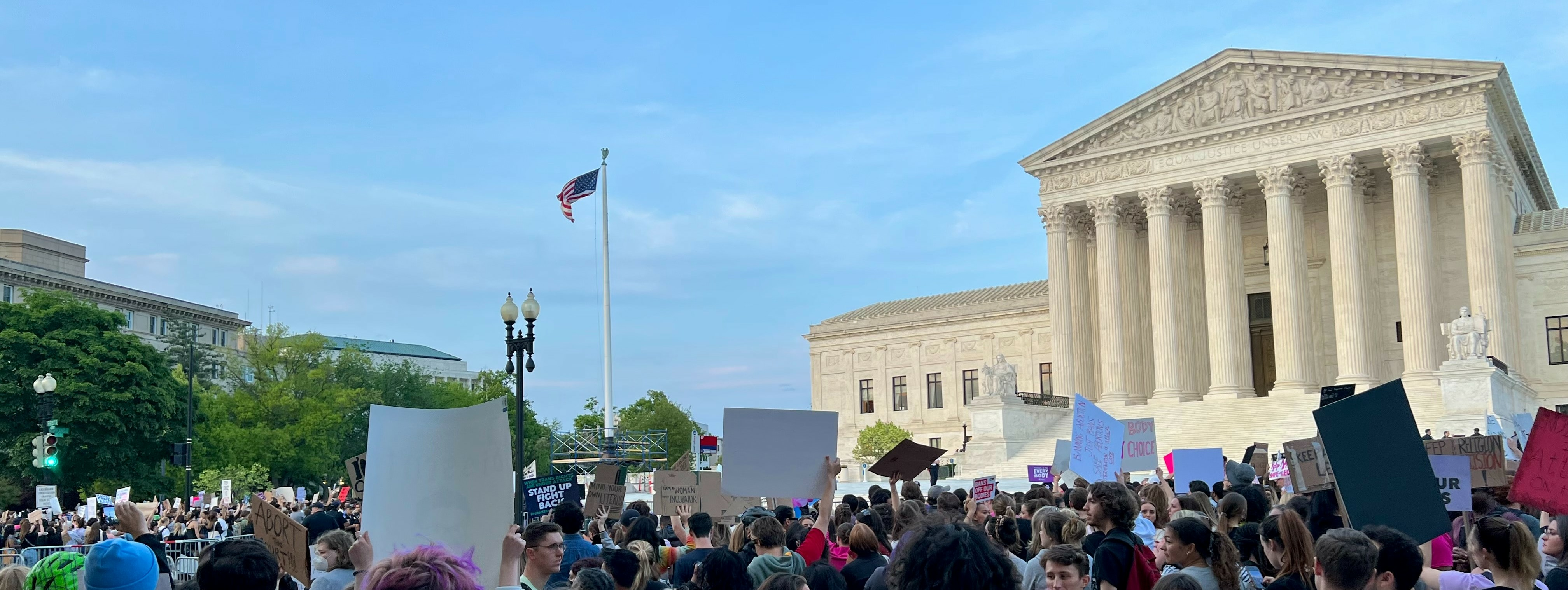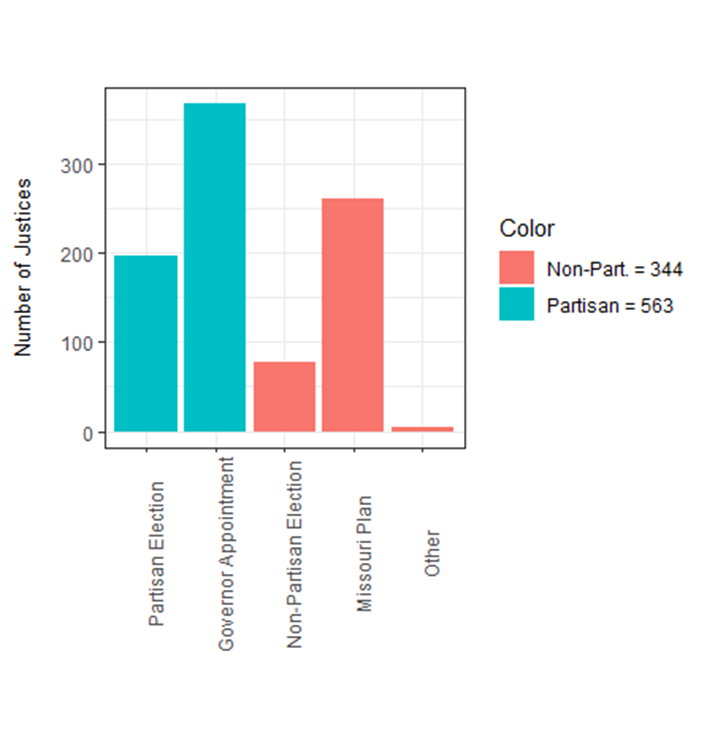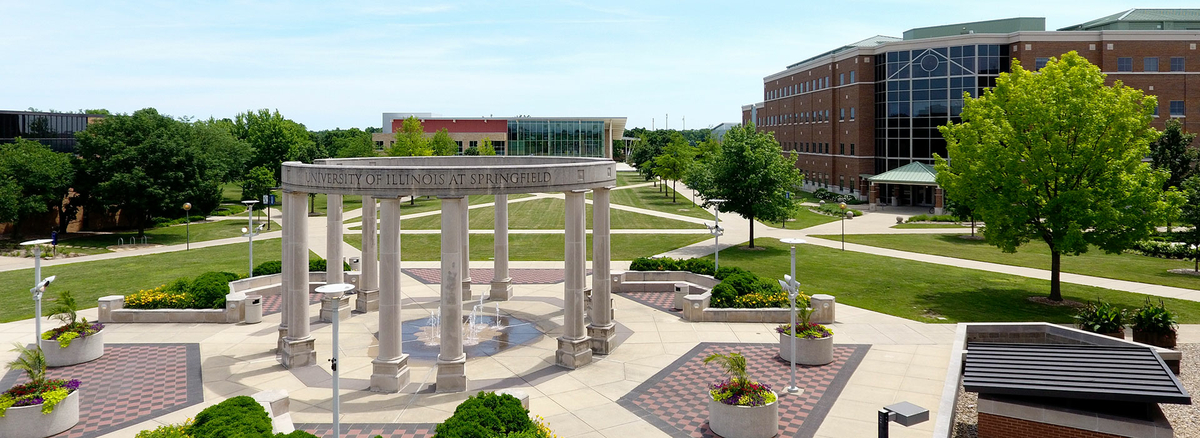Courting Extremism: How State Supreme Court Selection Methods Fuel Ideological Divides

Every summer when the US Supreme Court releases their most high-profile decisions the public is reminded of the influence judges have on everyday life. With cases on topics like abortion, affirmative action, and student loans, the courts are often the battlefield for the nation's most contentious and polarizing topics. Contentious topics often lead to questions of accountability.
How do we decide who gets to make these tough decisions?
You may remember that at the federal level (including the Supreme Court) judges are nominated by the president and confirmed by the Senate. But the majority of the nation's cases are heard in the state court system where the method of selection for judges is anything but uniform. It turns out the different methods of selection lead to important differences in the types of judges that preside in the various states.
If you don't know how the judges in your state are selected you aren't alone. In a recent survey of Illinois voters (the same survey you've seen in other blog posts), we found that only 37.2 percent could correctly state how their Supreme Court justices are picked. In general, state high court judges (the courts where the most important decisions are made at the state level) are selected through one of five methods.
- The state of Illinois uses partisan elections where judicial candidates run for a political party’s nomination and if selected go on to face the candidates of opposing parties in a general election. The judicial candidate’s partisan affiliation is listed on the ballot. Supporters of partisan judicial elections argue that the impact of politics and ideology is present in any judicial system, partisan elections are honest about that impact, and help voters select judges who align with their preferences.
- Some judges are appointed by a state’s governor or legislature. Just like with the federal courts, voters do not get a direct vote but rely on their representatives to make a selection. In most of the states that use this system, however, governors have few real checks on their appointment power. Supporters argue this is usually the most efficient selection method and allow governors to appoint judges that share their opinions.
- Non-partisan elections allow candidates from any party (or no party) to run without being identified by their partisanship. Usually after an initial primary the top two candidates face off in a general election. Proponents of this system argue that non-partisan elections push candidates to be more moderate to appeal to all voters instead of just those belonging to a single party and still give people a direct voice in selecting judges and holding them accountable.
- The “Missouri Plan” is a system where judges are chosen by a nominating commission. When there is a vacancy, the commission puts forward a list of candidates to a governor, from which the governor must pick a judge. In the next general election, voters then decide whether to retain or remove the judge. Arguments for Missouri Plan commissions focus on the belief that commissions place a greater emphasis on legal and judicial expertise, decreasing the role of politics, in the selection of justices.
- The least common method is non-partisan court appointments. In this system, the current judges on a state's high court select other judges or lawyers to fill vacancies. To the extent this method is used, it is often to make interim appointments.
According to our survey, a majority of Illinois voters (54 percent) would prefer non-partisan elections. Both voters and judges have said they think non-partisan elections would help remove party politics from the courts and allow citizens to hold judges accountable if they made controversial decisions.
For simplicity's sake, we can also categorize these methods as partisan and non-partisan based on the role of political parties in each system. Partisan methods require the involvement of party officials in the selection of judges. In these methods judges become associated with a political party and then broadcast that association (either intentionally or not) to decision-makers. These include appointments by elected officials and partisan elections. Non-partisan methods do not require prospective judges or their advocates to reveal any party affiliation. These include appointments through a Missouri Plan commission or non-partisan elections.

(The chart above shows that there were 196 partisan high court justices selected through partisan elections, 366 partisan justices were selected through Governor Appointment, 78 non-partisan justices were selected via non-partisan elections, 261 non-partisan justices were selected through the Missouri Plan, and 6 non-partisan justices were selected through other means)
The figure above shows the methods for high court judicial selections from 1961-2011. The majority of judges were selected through a partisan method. But with a still significant 38 per cent of judges selected through non-partisan means, we wanted to know: are the judges produced from these different systems inherently different?
Given the contentious decisions judges make every year, we looked at the ideological extremity of the same sample of judges used above. By ideological extremity, we don't mean whether a judge is a conservative or liberal but how conservative or liberal they are relative to other judges. We utilize an ideology extremity score based on the donations they have made to political candidates in their life or the sources from whom they have received donations. The more a judge donates to a liberal candidate or receives from liberal sources, the more liberal they appear using these scores (and vice versa). The scores range from 0 to 2.5 with an average of 0.572. Judges with financial relationships with both liberals and conservatives have a score closer to 0 (they are more moderate). Judges with a score further from zero are more extreme.
| Selection Method | Number of Judges | Extremity Score |
|---|---|---|
| Partisan Methods | 564 | 0.584 |
| Partisan Appointments | 366 | 0.591 |
| Partisan Elections | 196 | 0.571 |
| Non-Partisan Methods | 345 | 0.554 |
| Missouri Plan | 261 | 0.491 |
| Non-Partisan Elections | 78 | 0.778 |
| Court Appointments | 6 | 0.344 |
A quick look at our data reveals some surprising results. In general, judges that come from non-partisan selection methods are less extreme than partisan ones. Judges selected through the Missouri Plan or through the very rare court appointment are the least extreme. But surprisingly the most extreme average score belongs to judges from non-partisan elections, scoring nearly 0.2 greater than all other methods.
How do we square this with Illinois voters' preference for non-partisan elections? Are the voters just wrong to think they will remove politics from the courts? Could it be because this method allows extreme candidates to ``sneak'' into office without revealing their party affiliation to voters? Or do we simply not have enough observations to judge this relatively new method?
We won't make too many more proclamations based just on average scores, but this work is part of a growing research agenda at the Center for State Policy and Leadership. If you're interested in learning more about how we pick our judges and the consequences of our selection methods, keep an eye out for our forthcoming research articles.



